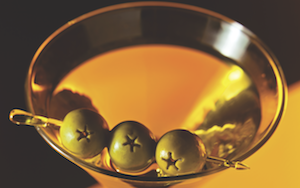“Cocktail bars and lounges are reinventing classic cocktails such as the Martini, Manhattan, Martinez or Negroni, where vermouth is a must among the few ingredients mixed together,” says Regan
Thomas Huhn, chef de bar of Les Trois Rois hotel in Basel, Switzerland, says: “Vermouth is for me a very important ingredient. It’s getting more and more popular and the choice of brands is amazing. As I started with my bartender career 14 years ago I used only the big brands in business – Martini and Cinzano – and these were the only available brands in Germany at this point.
“Over the years I have changed my mind and today I have a mix of local producers or brands with a long tradition and a traditional recipe for historical cocktails,” says Huhn.
“We have products from a small producer, Matter Luginbühl – a little bit more expensive but a higher quality and a nice story behind them.
“When I started I had a lot of fancy drinks on the menu but I used vermouth only for Martinis and Manhattans. Today we search for the classic recipes which give us the inspiration, the story and a huge playground to make our own twists,” he says.
“Trends come and go – I have now been seven years in Basel as bar manager and I made a lot of changes in my portfolio, but the tradition is still alive such as with Noilly Prat and Carpano,” says Huhn.
As to his favourite brands, Shaker’s Sood says: “Noilly is a good standard, versatile dry vermouth, Dolin is a good ‘underdog’ for pouring dry vermouth. I am a big fan of the Cocchi vermouth di Torino Cocchi Americano. I like Antica Formula, but it is very expensive and not affordable for bars that charge less than £10 a drink.”
Duff says: “To me, a good vermouth should offer a realistic representation of its base wine and be equally good for drinking straight as for mixing cocktails. I think we’ve moved on from using cheap base wines and concentrating on botanicals – just like in food and cocktails, quality and provenance is all. New brands such as EWG’s La Quintinye Vermouth Royal range and Martini’s Gran Lusso are leading the way in this, and several of the US brands such as Ransom (a rare US vermouth containing wormwood) and Imbue have a similar ingredient-driven philosophy, which I applaud.
“I can best illustrate my thoughts on the is-vermouth-old-fashioned-for-drinking-straight with an anecdote. During a panel discussion as part of the Vermouth Institute, an American audience member (who herself makes vermouth) asked one of those questions-which-is-really-a-statement along the lines of: “Why don’t Americans drink vermouth straight, or over ice, like Italians, French or Spanish?” I recall my own reply being something along the lines of: “Well, the chicken wings are shit in France,” by which I mean each country has valid drinking cultures. It becomes pathetic when we treat culture as a dressing-up box.
“Let the Mediterranean types drink vermouth on terraces while flirting with each others’ wives – us barbarian Anglo-Saxons can suck it down in fancy Manhattans and Martinis, or possibly Martini-and-lemonade-ice-and-a-slice-please. More important than either of those trends is that vermouth is being made, sold and drunk with more care and attention than in the past 50 years, and that’s only a good thing,” says Duff.




